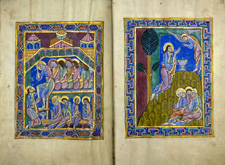Image
© Hildesheim, St Godehard |
THE WASHING
OF THE FEET
John 13:8-9
The apostles are arranged in two registers. The upper group is distinguished
by the rear view and hidden profiles while in the lower row each disciple
clutches a raised bare foot. Christ, on both knees and wearing a towel
tucked around his waist, washes Peter’s feet and talks to him. Peter
draws up his garment and holds his forehead.
Peter has just asked why Christ should wash his feet. Jesus, holding Peter’s
foot, replies ‘If I wash thee not, thou hast no part with me’,
and Peter’s gestures emphasise his words ‘Lord, not my feet
only but also my hands and my head’(John 13:8-9). The two disciples
on the right, at the end of the scene are asking whom Jesus means when
he says one of them shall betray him (John, 13, 22). Judas on pp41,42
has a receding hair line, like the disciple bottom row, second from the
right.
The two rows of apostles in this scene are an iconographic innovation.
The rear views in the upper row derive from Pentecost scenes, as shown
on p55. In the foot washing scene it is a
convenient way of hiding the apostles’ legs which would otherwise
dangle over the lower row. The position of the apostles in the lower row
is clarified in Byzantine examples such as the mosaics of Monreale where
they are actually removing their sandals. The St Albans artist, perhaps
unfamiliar with this type of shoe, has omitted the footwear.
An unusually vivid Anglo-Saxon innovation is the position of Christ on
both knees. In Byzantine examples he rather airily walks about (AP,
pl 127). In London, British Library, MS Cotton Tiberius C.VI, f11v, Christ
on both knees is preceded by an inscription ‘Hic fecit Jhs mandatum’
instead of the biblical ‘Hic dedit mandatum’. This
is a dramatic rendering of the abbot’s liturgical action of kneeling
to wash the feet of the poor on Maundy Thursday. Christ’s commandment
to love one another is performed rather than given. (Schapiro, 1943,150)
In the Bible, this scene is followed immediately by the Last Supper which
takes place in the same room. The Agony in the Garden which follows (p39,40)
is thus startlingly out of sequence (see ESSAY:
The Miniatures).
There is a scribal notation in ink on the lower right margin: h.
Quire 3.
Thread or stitch holes for protective curtain

Click
to enlarge
|
![]()